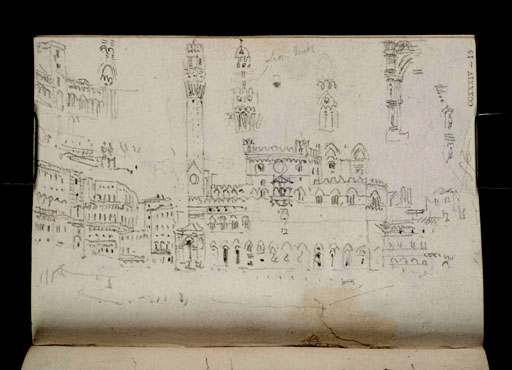Joseph Mallord William Turner The Piazza del Campo, Siena, with the Palazzo Pubblico and the Torre del Mangia 1828
Image 1 of 2
Joseph Mallord William Turner,
The Piazza del Campo, Siena, with the Palazzo Pubblico and the Torre del Mangia
1828
Folio 15 Recto:
The Piazza del Campo, Siena, with the Palazzo Pubblico and the Torre del Mangia 1828
D21616
Turner Bequest CCXXXIV 15
Turner Bequest CCXXXIV 15
Pencil on paper, 104 x148 mm
Inscribed in pencil by Turner ‘[?Lippo Memmi]’ towards top centre
Stamped in black ‘CCXXXIV – 15’ top right, ascending vertically
Inscribed in pencil by Turner ‘[?Lippo Memmi]’ towards top centre
Stamped in black ‘CCXXXIV – 15’ top right, ascending vertically
Accepted by the nation as part of the Turner Bequest 1856
References
1909
A.J. Finberg, A Complete Inventory of the Drawings of the Turner Bequest, London 1909, vol.II, p.719, CCXXXIV 15, as ‘At Sienna’.
1978
Alberto Satolli, ‘L’immagine di Orvietto nei disegni’ in Orvieto fuori d’Orvieto nella prima metà dell’800, 1978, p.149.
1984
Cecilia Powell, ‘Turner on Classic Ground: His Visits to Central and Southern Italy and Related Paintings and Drawings’, unpublished Ph.D thesis, Courtauld Institute of Art, University of London 1984, pp.303, 435.
1987
Cecilia Powell, Turner in the South: Rome, Naples, Florence, New Haven and London 1987, pp.[139]–140, 206 note 19, pl.144, as ‘Siena: the Campo’.
1991
Horst Koch, William Turner, Kirchdorf/Inn 1988, trans. Stephen Gorman, London 1991, reproduced p.103, p.140, as ‘Sienna’ (sic).
As noted by Cecilia Powell, this detailed architectural study depicts the Piazza del Campo, Siena’s principal square.1 Turning his sketchbook horizontally for a more panoramic effect, Turner looked south-east towards the city’s magnificent stone and red-brick town hall, the Palazzo Pubblico, a Gothic palace built in the late thirteenth and early fourteenth centuries.2 Showcasing Turner’s skilled architectural draughtsmanship, the tiers, turrets and projections are carefully outlined, and the doorways, arched windows and crenellations articulated with characteristic economy. Comparatively detailed sections of the building serve to indicate the overall scheme, whereas other parts are numbered or left blank to show the repetition of architectural features. For example, a row of first-storey windows is implied with the inscription ‘12’.
The tower to the left is the palace’s fourteenth-century campanile, the Torre del Mangia. It skims the top of the page as though to emphasise its impressive height, which exceeds 87 metres.3 As detailed here by Turner, the stone parapet and belfry towards the top are crenellated. A separate ‘exploded’ view to the right suggests Turner’s interest in aspects of its design and construction. The upper inscription is partly illegible but may be an abbreviation of ‘Lippo Memmi’, the architect tasked with designing the top part of the tower. This annotation hints at Turner’s curiosity towards the site’s architectural history, which perhaps led him to consult a guidebook.4
Several enlarged architectural features float across the top of the page: details of window tracery; an entablature; a side profile of an entrance portico; and the deconstructed parapet of the Torre del Mangia, mentioned earlier. The surrounding buildings in the square are also detailed, their windows and decorative features rendered as rows of dots, lines and other geometrical markings. Continuing the vista cut off by the border of the page, Turner included another row of buildings in the top-left corner above.
The time-saving devices used here, such as inconsistent detailing, enlarged architectural features and numbering to indicate repetition, were deployed to similar effect by Turner in a view of the Piazza del Duomo in Pisa: see the Genoa and Florence sketchbook from the present 1828 tour (Tate D21527; Turner Bequest CCXXXIII 59a). A notable difference is the absence of figures in the present view of Siena.
For further commentary on Turner’s first visit to Siena in 1828, together with a list of relevant works in the sketchbook, see under folio 10 verso (D21607).
Hannah Kaspar
November 2024
‘Palazzo Pubblico in Siena’, Visit Siena, accessed 24 June 2024, https://visitsienaofficial.it/en/palazzo-pubblico-in-siena/ .
‘Torre del Mangia’, Visit Tuscany, accessed 24 June 2024, https://www.visittuscany.com/en/attractions/torre-del-mangia/ .
‘Torre del Mangia’, Visit Tuscany, accessed 24 June 2024, https://www.visittuscany.com/en/attractions/torre-del-mangia/ .
How to cite
Hannah Kaspar, ‘The Piazza del Campo, Siena, with the Palazzo Pubblico and the Torre del Mangia 1828’, catalogue entry, November 2024, in David Blayney Brown (ed.), J.M.W. Turner: Sketchbooks, Drawings and Watercolours, Tate Research Publication, February 2025, https://www


